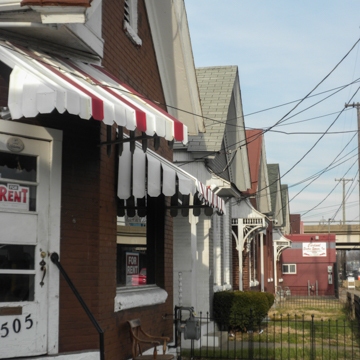Charles Stecker emigrated from Germany to Louisville, Kentucky, where he became the owner of a tanning business in the predominantly German Butchertown neighborhood. Between 1912 and 1915 Stecker built twenty-four shotgun cottages on and near Mellwood Avenue, several of which are still standing.
According to John Michael Vlach, the shotgun house developed syncretically with references to the Yoruba Abuja house type, the Bohio house of the Arawak peoples of the Caribbean, and the French Maison Basse type. The shotgun house came into its own as a Southern house type after an influx of Haitians to New Orleans in 1809. The shotgun house migrated north along the Mississippi River and first appeared on Louisville’s Shippingport Island near the site of the Portland Canal shortly after the Civil War. Decimated by the great flood of 1937, this area no longer exists.
Louisville’s population of 100,000 in 1870 had doubled by 1900. Immigrants from Germany, Ireland, Scotland, Switzerland, and Italy, who came to work in Louisville’s factories, needed rental properties in areas close to their places of employment. Charles Stecker was one of hundreds of local entrepreneurs to cater to this emergent market; concentrations of shotgun cottages can be found in Louisville’s Portland, Germantown, and California neighborhoods, as well as in Butchertown.
The shotgun cottages on Mellwood Avenue are typical; they are between twelve and fifteen feet wide and are three rooms deep with no hallways. Originally, they did not include interior bathrooms or toilets. All of the houses on this block have front doors on the left and two large, vertically-oriented sash windows to the right. Stecker built his rental cottages of common bond brick with gingerbread or Carpenter Gothic-style spindles and other millwork decorating the small porches over the front door, the block-long cumulative effect of which is charming.
Despite the limitations of space in the three room shotgun, there is considerable variation in how occupants use the rooms; the front room might be the parlor or a bedroom, the second might be a dining room or bedroom, but the third room is almost always the kitchen. There is also considerable variation in the location of added bathrooms. Some semblance of privacy is afforded to the occupants of the tightly spaced shotgun cottages if there are windows on only one of the long sides of the house and if that side is consistent with its neighbors.
Because of the devastation in New Orleans following Hurricane Katrina in 2005, Louisville now has the greatest number of shotgun cottages in any American city. The Preservation Alliance of Louisville promotes the shotgun house as a viable type, both for its historic resonance and its affordability.
References
Preservation Alliance of Louisville and Jefferson Co. The Shotgun House: Urban Housing Opportunities. Louisville: Preservation Alliance of Louisville and Jefferson Co., 1980.
Vlach, John Michael. “The Shotgun House: An African Architectural Legacy.” In Common Places: Readings in American Vernacular Architecture, edited by Dell Upton and John Michael Vlach, 58-78. Athens, GA: University of Georgia Press, 1986.











